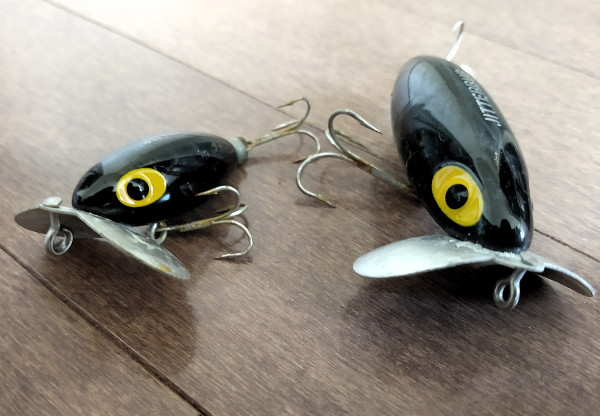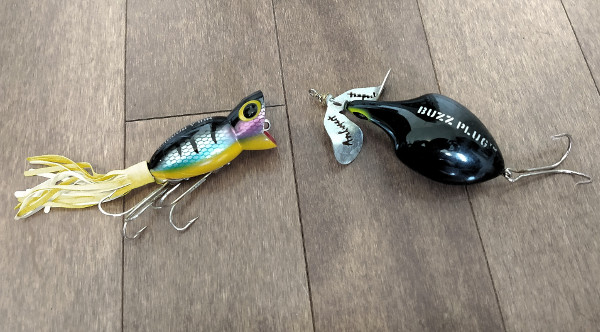The Arbogast Jitterbug is a classic lure with a history many decades old. It was invented by Fred Arbogast in 1938, and has consistently proven itself as an effective fishing plug since then, especially for largemouth bass (although a large variety of fish species have been caught on this lure).
 But you didn’t come here for a history lesson, you came here to learn how to fish a Jitterbug! This is one of the best night time bass baits out there. Let’s dive into the details on how to use a Jitterbug lure.
But you didn’t come here for a history lesson, you came here to learn how to fish a Jitterbug! This is one of the best night time bass baits out there. Let’s dive into the details on how to use a Jitterbug lure.
This post uses amazon affiliate links. I receive commission from any sales at no additional cost to yourself.
How to fish a Jitterbug?
Unlike many topwater lures, the jitterbug does not pop. You are likely used to a variety of fishing techniques with the topwaters you fish, this is not necessary with the Jitterbug. The unique lip design will provide all the action for you. I like to think it mimics a mouse scrambling across the water’s surface.
When retrieved, the Jitterbug should wobble side to side. You can vary the speed of the retrieve a bit, and a steady retrieve like this will often produce fish. The rhythm of the lure wobbling back and forth causes alot of commotion. Even if the bass are not hungry, it might just piss them off enough to strike it.
An even more effective method for Jitterbug fishing is to use the stop and go technique. Retrieve the jitterbug for a few seconds, and pause anywhere from a few seconds to fifteen seconds. Repeat. The strike will often come during the pause, although you’ll get a few strikes just as it starts moving again. This technique is a great way to trigger strikes from both largemouth and smallmouth bass, in addition to pike.
I’d also recommend letting the lure sit for a bit after you cast out. After the lure lands with a plop, let it sit for a good twenty seconds before retrieving. Many times a fish will strike before you even start reeling it back in!
If you had a missed strike during the retrieve, it’s worth while to cast out to the same spot again. Bass feeding on topwater are aggressive, and will often strike a second, or even third time.
When you do get a strike, resist the urge to immediately set the hook. Allow the bass time to re-position the lure in it’s mouth, you should feel the weight of the bass before setting the hook. This is true of most topwater lures, even more so on hollow body frogs. You have a few bass spit it out before re-positioning, but the hook up rate on the bass that do re-position the lure will be much higher.
Jitterbugs are not weedless, so you’ll have to cast around the weeds. casting to the edge of the weeds and retrieving along the weed line is a very effective technique for largemouth bass.
That’s it for *how* to fish a jitterbug. As mentioned earlier, the lip provides the action, so it’s not as versatile as some other lures. That being said, it’s a very unique action that’s hard to replicate with other lures. The signature side to side wobble has a proven track record of catching big bass.
Canadian user click here Jitterbug (Amazon Link)
When to fish a Jitterbug?
Although it can be effective during the day, the jitterbug really shines at night, dusk, and dawn. It also performs well on overcast days, basically any low-light conditions is ideal to fish a Jitterbug. This is a good rule of thumb for most topwaters actually.
This isn’t to say you can’t catch fish on a Jitterbug in the middle of the day, people do! But odds are you’ll have much better luck fishing it at night.
As to the time of year? Summer tends to be best, with the bite improving into late summer and early fall. The frogs are very abundant this time of year, and it’s the time to be using topwaters. If you’re fishing a body of water that you suspect has a high mouse population around it, spring is also likely to be a productive time of year for topwaters. The mice are just waking out of hibernation in the spring, and often fall into the water while foraging for food.
Where to fish a Jitterbug?
The most important part about choosing where to fish a Jitterbug is the water conditions. The plug needs to be fished on calm water. The action is severely affected by choppy or wavy water, and you’re better off using other topwater lures (such as poppers or floating stick baits) in these conditions. The jointed Jitterbug does tend to handle choppy water better than the original model, but it has it’s limits as well.
Fish the Jitterbug near structure that fish are likely to be holding in. Submerged logs or trees, large rocks, eddies, breaks in current, overhanging trees, reeds, lily pads, sand bars, docks, etc are all examples of structure likely to hold fish. The most productive structure varies by species and type of water fished, but these are some solid starting points. Research the specific species you’re targeting for more detailed information on where your target fish species is likely to be holding.
What colour lure to use?
There are two ways to decide what colour of Jitterbug to fish. You can either base the colour on the fishing conditions, or on local prey available.
The silhouette of dark lures show up better at night than brightly coloured lures. Since Jitterbugs are most effective at night, dawn, and dusk, having a black jitterbug in your box is a must. Black is a good starting colour if you’re only buying one Jitterbug to try it out.
On the flip side, mimicking the colour of natural prey species is also a very effective way of deciding on what colour lure to use. Arbogast has made the Jitterbug available in a large variety of colours, specifically in multiple different frog patterns. Frogs are a common topwater prey item of bass and many other species of fish, so choosing a frog pattern makes sense. Using natural colours like this is great early dusk, late dawn, or on cloudy, overcast days.
Mice are another very common topwater prey item, and their underside is quite lightly coloured. I like the white with a red head colour pattern for mimicking a mouse. This colour combination has a long history of effectiveness on topwater lures for striped bass in salt water. The white mimics a mouse’s belly, while the red head is a hotspot to catch the bass’s attention. This is also a great colour if you’re going to try your luck fishing Jitterbugs during a bright sunny day.
In addition to colour, there’s also the choice between the classic jitterbug versus jointed jitterbug. While the original is a very effective classic, the jointed Jitterbug just improves on it’s design. The joint combines nicely with the side to side action of the lure’s lip to produce a very nice wiggle. The rear of the lure also sits lower in the water when paused, changing the presentation. This also make the hooks sit lower in the water, which can improve the hook up rate.
I’ve heard other anglers say they catch less bass on the jointed ones, but the bass they do catch tend to be bigger. Each lure has it’s place. Use the jointed one if you’re trophy hunting, and the original if you’re not getting any bites with the jointed Jitterbug.
What types of fish can I catch using a Jitterbug?
Quite simply, most anything that feeds off the surface. Largemouth bass are the classic target when fishing the Jitterbug, but the lure works on a large number of species. Smallmouth bass eagerly strike topwater baits and the Jitterbug is no exception. Large brook trout, rainbow trout, and brown trout will also all take a Jitterbug, especially in areas that they’re feeding on rodents. The smaller models tend to work better on trout (even big trout).
Other species that will strike Arbogast’s famous lure include striped bass, panfish (smaller sized models), pike, musky, pickerel, and even catfish.
Many saltwater species will strike at a jitterbug as well, the trick is to find water that’s calm enough for the lure to perform properly. Wave’s really mess with the plugs action. Estuaries, inlets, and harbours are good options for trying this lure in salt water. As mentioned earlier, the jointed Jitterbug handles choppy-ness better than the original model, and would be a better choice for saltwater fishing.
Other Arbogast lures
 Arbogast has built it’s reputation on topwater lures. The Jitterbug is a classic lure that has been around for many years. The Hula Popper is another topwater lure from Arbogast that also has a long reputation of catching fish. The popping action on this lure is amazing, and I love the skirt that comes with it.
Arbogast has built it’s reputation on topwater lures. The Jitterbug is a classic lure that has been around for many years. The Hula Popper is another topwater lure from Arbogast that also has a long reputation of catching fish. The popping action on this lure is amazing, and I love the skirt that comes with it.
The Arbogast buzz plug is the lesser known cousin to the Hula Popper and Jitterbug. It’s still a very effective lure, and makes even more commotion on the water than the Arbogast’s other two lures. The action is very similar to other bass buss baits. A finesse lure this is not, it’s best used on bass you know are feeding. There is also a buzz plug jr available, this smaller one slays smallies.

I’m 71, and the largest bass I’ve ever caught was a 12 pounder. The fish hit a 5/8 oz sputterbug at 11am in 90 degree weather in June 1972. My earlier experience with farm pond bass had convinced me that bass will sometimes come to the surface for something noisy, even in bright light and very hot conditions. The sputterbug has always been my favorite top water plug.